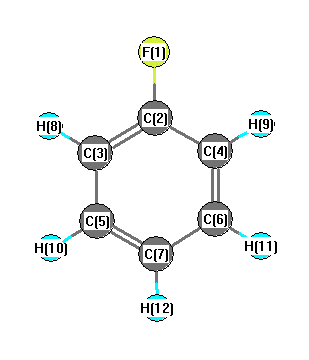Geometric Data

Point Group C2v
Internal coordinates
distances (r) in Å, angles (a) in degrees, dihedrals (d) in degrees
Cartesians
| Atom |
x (Å) |
y (Å) |
z (Å) |
| F1 |
0.0000 |
0.0000 |
-2.2030 |
| C2 |
0.0000 |
0.0000 |
-0.8490 |
| C3 |
0.0000 |
-1.2170 |
-0.1930 |
| C4 |
0.0000 |
1.2170 |
-0.1930 |
| C5 |
0.0000 |
-1.2080 |
1.2020 |
| C6 |
0.0000 |
1.2080 |
1.2020 |
| C7 |
0.0000 |
0.0000 |
1.9030 |
| H8 |
0.0000 |
-2.1370 |
-0.7610 |
| H9 |
0.0000 |
2.1370 |
-0.7610 |
| H10 |
0.0000 |
-2.1470 |
1.7430 |
| H11 |
0.0000 |
2.1470 |
1.7430 |
| H12 |
0.0000 |
0.0000 |
2.9830 |
Atom - Atom Distances 
Distances in Å
| |
F1 |
C2 |
C3 |
C4 |
C5 |
C6 |
C7 |
H8 |
H9 |
H10 |
H11 |
H12 |
| F1 |
|
1.3540 | 2.3497 | 2.3497 | 3.6129 | 3.6129 | 4.1060 | 2.5780 | 2.5780 | 4.4923 | 4.4923 | 5.1860 |
| C2 |
1.3540 |
|
1.3825 | 1.3825 | 2.3803 | 2.3803 | 2.7520 | 2.1388 | 2.1388 | 3.3657 | 3.3657 | 3.8320 |
| C3 |
2.3497 | 1.3825 |
|
2.4340 | 1.3950 | 2.7976 | 2.4237 | 1.0812 | 3.4018 | 2.1478 | 3.8813 | 3.4012 |
| C4 |
2.3497 | 1.3825 | 2.4340 |
|
2.7976 | 1.3950 | 2.4237 | 3.4018 | 1.0812 | 3.8813 | 2.1478 | 3.4012 |
| C5 |
3.6129 | 2.3803 | 1.3950 | 2.7976 |
|
2.4160 | 1.3967 | 2.1717 | 3.8785 | 1.0837 | 3.3983 | 2.1520 |
| C6 |
3.6129 | 2.3803 | 2.7976 | 1.3950 | 2.4160 |
|
1.3967 | 3.8785 | 2.1717 | 3.3983 | 1.0837 | 2.1520 |
| C7 |
4.1060 | 2.7520 | 2.4237 | 2.4237 | 1.3967 | 1.3967 |
|
3.4152 | 3.4152 | 2.1530 | 2.1530 | 1.0800 |
| H8 |
2.5780 | 2.1388 | 1.0812 | 3.4018 | 2.1717 | 3.8785 | 3.4152 |
|
4.2740 | 2.5040 | 4.9621 | 4.3110 |
| H9 |
2.5780 | 2.1388 | 3.4018 | 1.0812 | 3.8785 | 2.1717 | 3.4152 | 4.2740 |
|
4.9621 | 2.5040 | 4.3110 |
| H10 |
4.4923 | 3.3657 | 2.1478 | 3.8813 | 1.0837 | 3.3983 | 2.1530 | 2.5040 | 4.9621 |
|
4.2940 | 2.4794 |
| H11 |
4.4923 | 3.3657 | 3.8813 | 2.1478 | 3.3983 | 1.0837 | 2.1530 | 4.9621 | 2.5040 | 4.2940 |
|
2.4794 |
| H12 |
5.1860 | 3.8320 | 3.4012 | 3.4012 | 2.1520 | 2.1520 | 1.0800 | 4.3110 | 4.3110 | 2.4794 | 2.4794 |
|
Calculated geometries
for C
6H
5F (Fluorobenzene).
Experimental Bond Angles (degrees) from cartesians 
| atom1 |
atom2 |
atom3 |
angle |
|
atom1 |
atom2 |
atom3 |
angle |
| F1 |
C2 |
C3 |
118.326 |
|
F1 |
C2 |
C4 |
118.326 |
| C2 |
C3 |
C5 |
117.956 |
|
C2 |
C3 |
H8 |
119.983 |
| C2 |
C4 |
C6 |
117.956 |
|
C2 |
C4 |
H9 |
119.983 |
| C3 |
C2 |
C4 |
123.348 |
|
C3 |
C5 |
C7 |
120.496 |
| C3 |
C5 |
H10 |
119.579 |
|
C4 |
C6 |
C7 |
120.496 |
| C4 |
C6 |
H11 |
119.579 |
|
C5 |
C3 |
H8 |
122.060 |
| C5 |
C7 |
C6 |
119.747 |
|
C5 |
C7 |
H12 |
120.127 |
| C6 |
C4 |
H9 |
122.060 |
|
C6 |
C7 |
H12 |
120.127 |
| C7 |
C5 |
H10 |
119.925 |
|
C7 |
C6 |
H11 |
119.925 |
Bond descriptions
Examples: C-C single bond, C=C, double bond, C#C triple bond, C:C aromatic bond
| Bond Type |
Count |
| C-F |
1 |
| H-C |
5 |
| C:C |
6 |
Connectivity
| Atom 1 |
Atom 2 |
| F1 |
C2 |
| C2 |
C3 |
| C2 |
C4 |
| C3 |
C5 |
| C3 |
H8 |
| C4 |
C6 |
| C4 |
H9 |
| C5 |
C7 |
| C5 |
H10 |
| C6 |
C7 |
| C6 |
H11 |
| C7 |
H12 |












